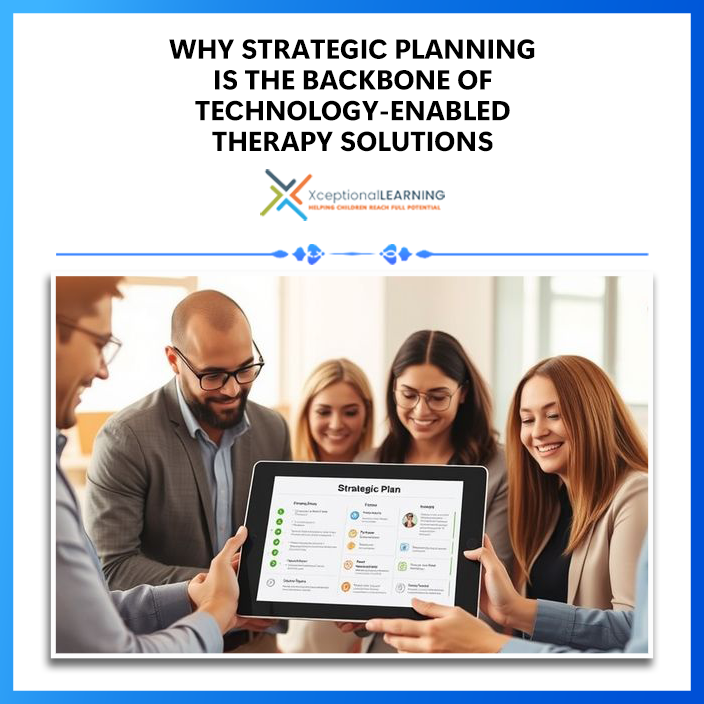Why Strategic Planning Is the Backbone of Technology-Enabled Therapy Solutions
admin July 16th, 2025

Clinically Reviewed by
Consultant Psychologist, Special Educator & Digital Therapy Trainer
The world of therapy is undergoing a dramatic transformation. Traditional face-to-face approaches are increasingly enhanced by digital tools that promise to improve engagement, efficiency, and outcomes. Whether in speech therapy, occupational rehabilitation, or special education, technology now plays a central role. But in the rush to adopt these innovations, it’s easy to overlook one essential truth: success in therapy depends not just on the tools we use, but on how we plan to use them. Strategic planning ensures that technology becomes an enabler, not a distraction. It helps professionals align digital solutions with therapeutic goals, client needs, and long-term sustainability. This blog explores why strategic planning is critical for technology-enabled therapy. We’ll cover common challenges, practical strategies, and how therapists, educators, and clinics can embed planning into their digital transformation journeys.
1. Technology Should Serve the Goals, Not Lead Them
One of the biggest mistakes in digital therapy implementation is letting the technology itself dictate the direction. Apps and tools may seem exciting and visually engaging, but if they don’t directly support the client’s needs, they can derail progress.
Example: If a child’s therapy objective is to develop expressive language skills, the technology used should include structured opportunities for verbal communication, sentence building, and visual prompts. Using general-purpose games that entertain without focusing on speech may create unnecessary distractions.
Strategic Solution:
- Start with a thorough needs assessment and create a goal-oriented therapy plan.
- Select digital tools that support these goals—not just what’s popular.
- Customize modules to reflect the client’s developmental stage and communication style.
Takeaway: The therapy comes first, and the technology follows.
2. Creating Continuity Across Settings
Children and adults in therapy often engage in multiple environments—home, school, and clinical sessions. For progress to be meaningful, strategies must remain consistent across these spaces.
Challenges Without Planning:
- Inconsistent use of tools leads to confusion.
- Parents and teachers feel unsure about how to support therapy outside the session.
- Clients receive mixed messages and lose momentum.
Strategic Solution:
- Develop shared digital therapy plans that can be accessed by caregivers and educators.
- Use platforms that allow therapists to assign and share activities remotely.
- Provide simple guides or videos to help non-professionals use the tools effectively.
Outcome: Seamless carryover of therapeutic strategies between sessions and daily life.
3. Collecting and Using Data Effectively
Many therapy platforms offer robust data collection—tracking accuracy, completion rates, and response times. However, data is only valuable when used strategically.
Key Strategic Questions:
- What data points matter most for this individual?
- How often should progress be reviewed?
- What will we adjust based on these metrics?
Strategic Solution:
- Identify 3–5 core progress indicators relevant to therapy goals.
- Establish regular review intervals (e.g., monthly).
- Use the data to inform pacing, activity selection, or intervention adjustments.
Important: Avoid data overload. Focus only on what helps make clinical decisions.
4. Increasing Efficiency and Scalability
Digital therapy tools promise to streamline workflows and reduce time spent on preparation. However, without a strategy, they can increase the administrative burden.
Without Strategic Planning:
- Therapists waste time exploring irrelevant tools.
- Sessions become inconsistent due to a lack of structure.
- Clinics can’t scale services effectively.
With Strategic Planning:
- Teams build shared content libraries tailored to common goals.
- Templates, routines, and protocols are standardized.
- Automations handle reporting and communication where appropriate.
End Result: More time spent on therapy, less on logistics.
5. Preventing Overstimulation and Distraction
Children with attention, sensory, or cognitive differences are especially vulnerable to overstimulation. Bright visuals, sounds, and fast-paced activities may become more harmful than helpful.
Strategic Solution:
- Select platforms with simple, calming interfaces.
- Set clear screen time limits and use visual schedules.
- Opt for content designed with therapeutic intent, not general entertainment.
Implementation Tip: Pilot digital tools with small groups first to assess tolerance levels before scaling up.
Impact: A more focused, calming environment that supports, rather than competes with, therapy.
6. Empowering Parents, Educators, and Care Teams
Technology has the power to unify everyone involved in a client’s progress—but only if communication is clear and expectations are aligned.
Common Challenges:
- Parents don’t know how to use the tools.
- Teachers may be unsure how to integrate therapy into classroom routines.
- Therapists feel isolated in tech adoption.
Strategic Solution:
- Conduct regular strategy check-ins with all stakeholders.
- Create user-friendly reports and progress visuals.
- Provide onboarding resources like PDFs, video demos, and quick-access help guides.
Result: A connected, collaborative care ecosystem where everyone knows their role.
7. Ensuring Long-Term Sustainability
Technology comes with hidden costs—hardware updates, staff training, licensing fees, and technical support. Without a sustainability plan, clinics may waste time and money on unused or ineffective tools.
Strategic Planning Components:
- Budget forecasting (short and long-term)
- Clear technology maintenance schedules
- Training and support structures
- Periodic usage reviews to determine Return on Investment (ROI)
Best Practice: Revisit your plan every 6–12 months to ensure tools are still relevant and impactful.
8. Building Flexibility for Diverse Needs
Every client has a unique profile—learning style, language preference, physical ability, and sensory profile. A rigid system can exclude those who don’t “fit the mold.”
Strategic Planning Allows You To:
- Modify tasks for nonverbal users or alternate communication styles
- Adjust difficulty levels and response types
- Incorporate multi-sensory input (visual, auditory, tactile)
- Make content culturally and linguistically inclusive
Outcome: Therapy that grows with the child, not one-size-fits-all programs.
9. Training: The Missing Link in Technology Adoption
Even the most advanced technology will fail without proper training. Staff may be hesitant, underprepared, or unaware of key features unless ongoing learning is part of the strategy.
Strategic Solution:
- Schedule monthly or quarterly refresher sessions
- Develop quick-reference guides and video walkthroughs
- Identify “tech champions” on your team to support peers.
- Include caregivers in the training process
Professional Tip: Make training interactive and reward participation to increase engagement.
10. Innovation with Intention
Innovation is exciting—but chasing every new trend without purpose leads to waste and confusion. Strategic planning encourages thoughtful adoption.
Smart Adoption Framework:
- Identify a clear need or gap.
- Research tools that address the gap.
- Test on a small scale (pilot program).
- Collect feedback and adjust.
- Launch with structured onboarding and ongoing review.
Remember: Innovation should support your mission—not replace it.
Conclusion: Planning First, Technology Second
Technology in therapy is a powerful enabler—but it is not a solution by itself. Strategic planning gives therapy its shape, structure, and sustainability. It ensures that each digital interaction has a purpose and contributes to meaningful progress.
By building thoughtful, well-rounded plans around technology integration, therapy professionals can:
- Increase efficiency
- Improve outcomes
- Empower families
- Scale services effectively
Ultimately, strategic planning ensures that technology serves its true purpose: enabling better, smarter, and more compassionate therapy. With platforms like XceptionalLEARNING, therapy professionals can build thoughtful, goal-oriented plans using tools such as the Digital Activity Book, designed to support diverse developmental needs. These solutions not only increase efficiency but also empower families and caregivers to be active participants in the therapeutic journey. Whether you’re looking to connect with licensed therapists online or searching for the best therapy platform for therapists, integrating digital solutions strategically makes all the difference. Contact us today to explore how our Specialized Therapy Services can help you deliver more personalized, scalable, and compassionate care.

